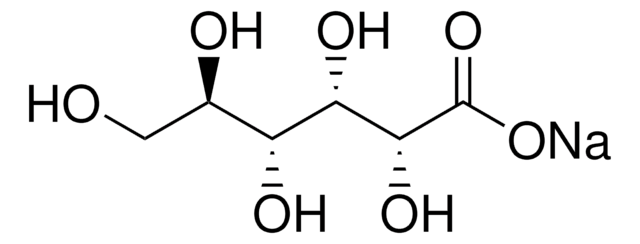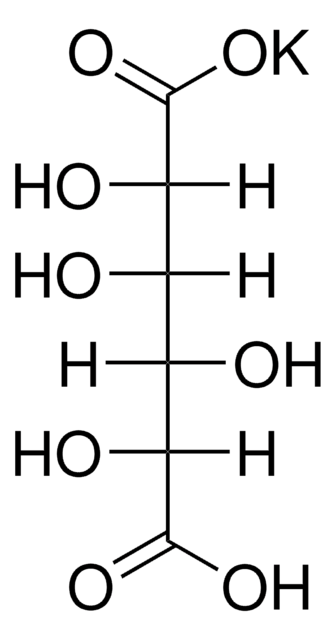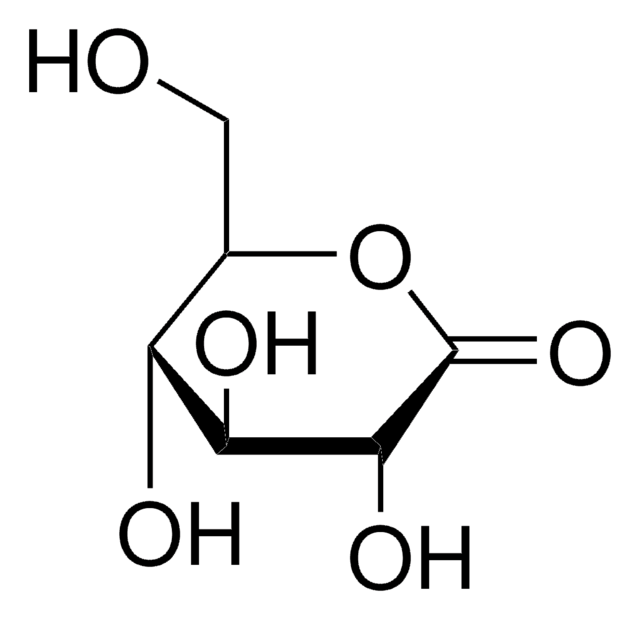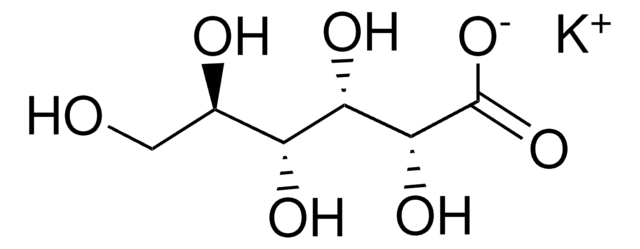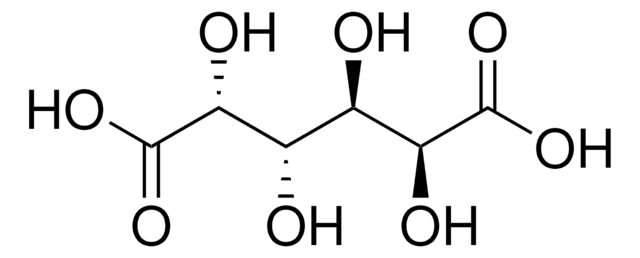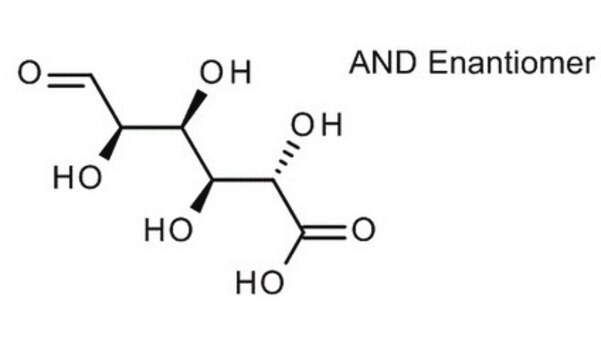G1951
D-Gluconic acid solution
49-53 wt. % in H2O
Synonym(s):
2,3,4,5,6-Pentahydroxycaproic acid
Sign Into View Organizational & Contract Pricing
All Photos(1)
About This Item
Empirical Formula (Hill Notation):
C6H12O7
CAS Number:
Molecular Weight:
196.16
Beilstein:
1726055
MDL number:
UNSPSC Code:
12352201
PubChem Substance ID:
NACRES:
NA.22
Recommended Products
form
viscous liquid
Quality Level
optical activity
[α]/D +9.0 to 15.5°
concentration
49-53 wt. % in H2O
refractive index
n20/D 1.4161
density
1.234 g/mL at 25 °C
SMILES string
OC[C@@H](O)[C@@H](O)[C@H](O)[C@@H](O)C(O)=O
InChI
1S/C6H12O7/c7-1-2(8)3(9)4(10)5(11)6(12)13/h2-5,7-11H,1H2,(H,12,13)/t2-,3-,4+,5-/m1/s1
InChI key
RGHNJXZEOKUKBD-SQOUGZDYSA-N
Looking for similar products? Visit Product Comparison Guide
Application
D-Gluconic acid is a non-volatile, organic acid generally used as a sequestering agent and as a scale inhibitor. Due to its tendency to chelate with earth alkaline elements and heavy metals, it is also used as a metal extractant. Gluconic acid and its salts are
used in hygienic products, food and pharmaceutical industry.
used in hygienic products, food and pharmaceutical industry.
Storage Class Code
10 - Combustible liquids
WGK
WGK 1
Flash Point(F)
Not applicable
Flash Point(C)
Not applicable
Personal Protective Equipment
dust mask type N95 (US), Eyeshields, Gloves
Choose from one of the most recent versions:
Already Own This Product?
Find documentation for the products that you have recently purchased in the Document Library.
Customers Also Viewed
Gluconic acid: Properties, applications and microbial production.
Ramachandran S, et al.
Food Technology and Biotechnology, 44(2) (2006)
Removal of heavy metals from soil components and soils by natural chelating agents. Part II. Soil extraction by sugar acids.
Fischer K and Bipp HP
Water, Air, and Soil Pollution, 138(1-4), 271-288 (2002)
Sheba Khan et al.
PloS one, 15(8), e0238252-e0238252 (2020-08-29)
We report on aerobic "environmental" bacteria isolated from European honey bees (Apis mellifera). We determined the number of culturable aerobic bacteria in the gut of nurse bees sampled from locations around Australia. Bees from healthy colonies had 107-108 aerobic bacteria
Mallory L Hammock et al.
Advanced materials (Deerfield Beach, Fla.), 26(35), 6138-6144 (2014-07-23)
Organic field-effect transistor (OFET) sensors can meet the need for portable and real-time diagnostics. An electronicreadout enzyme-linked immunosorbent assay using OFETs for the detection of a panel of three biomarkers in complex media to create a pre-eclampsia prognostic is demonstrated
Ubaid H Shah et al.
Clinical nutrition (Edinburgh, Scotland), 32(2), 193-199 (2012-09-18)
Acute lower respiratory infections are the most frequent illnesses globally in children less than 5 years old. The aim of this randomized double blind controlled trial is to assess the effectiveness of zinc gluconate supplementation for 2 months period compared
Our team of scientists has experience in all areas of research including Life Science, Material Science, Chemical Synthesis, Chromatography, Analytical and many others.
Contact Technical Service

